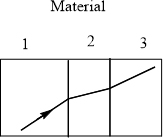
Concept explainers
(a) To determine:
The material which has the largest index of refraction, if a ray of light is refracted through three different materials

Answer to Problem 14Q
Solution:
When a light ray bends towards normal after refraction, then it has moved from a lower refractive index medium to a higher refractive index medium. When light ray bends away from the normal after refraction, it has moved from a higher refractive index medium to a lower refractive index medium.
The largest refractive indices of materials 1, 2, 3 are in the order of material 2 > material 1 > material 3
Explanation of Solution
Given:
A ray of light is refracted through three different materials
Formula used:
The Snell’s law describes that, when the light passes from one transparent medium into another with a different index of refraction, it bents and is given by
Where,
the angle of incidence and the angle of refraction;
are the respective indices of refraction in the materials.
Calculation:
Snell’s law shows that if then .
Thus, if light enters a medium where n is greater (and its speed is less), the ray is bent towards the normal. And if then , so the ray bends away from the normal.
The light bent towards the normal in the material 2 with respect to 1 and it bent away from the normal with respect to 2.
Analyzing the given specimen, the light bent towards the normal is greater in material 2 than material 1. And, in the material 3, the light bents away from the normal. Hence, material 3 has the least refractive index and material 2 has the largest index than the material 2. Hence, the materials are listed in the order of the largest refractive indices as material 2 > material 1 > material 3.
(b) To determine:
The material which has the smallest index of refraction if a ray of light is refracted through three different materials

Answer to Problem 14Q
Solution:
The materials are listed in the order of the smallest refractive indices as material 3 < material 1 < material 2
Explanation of Solution
A ray of light is refracted through three different materials.
When a light ray bends towards normal after refraction, then it has moved from a lower refractive index medium to a higher refractive index medium. When light ray bends away from the normal after refraction, it has moved from a higher refractive index medium to a lower refractive index medium.
Analyzing the given specimen, the light bent towards the normal is greater in material 2 than material 1. And, in the material 3, the light bents away from the normal. Hence, material 3 has the least refractive index and material 2 has the largest index than the material 2. Hence, the materials are listed in the order of the smallest refractive indices as material 3 < material 1 < material 2
Chapter 23 Solutions
Physics: Principles with Applications
Additional Science Textbook Solutions
Modern Physics
The Cosmic Perspective
Conceptual Physical Science (6th Edition)
University Physics with Modern Physics (14th Edition)
Essential University Physics: Volume 1 (3rd Edition)
Introduction to Electrodynamics
 College PhysicsPhysicsISBN:9781305952300Author:Raymond A. Serway, Chris VuillePublisher:Cengage Learning
College PhysicsPhysicsISBN:9781305952300Author:Raymond A. Serway, Chris VuillePublisher:Cengage Learning University Physics (14th Edition)PhysicsISBN:9780133969290Author:Hugh D. Young, Roger A. FreedmanPublisher:PEARSON
University Physics (14th Edition)PhysicsISBN:9780133969290Author:Hugh D. Young, Roger A. FreedmanPublisher:PEARSON Introduction To Quantum MechanicsPhysicsISBN:9781107189638Author:Griffiths, David J., Schroeter, Darrell F.Publisher:Cambridge University Press
Introduction To Quantum MechanicsPhysicsISBN:9781107189638Author:Griffiths, David J., Schroeter, Darrell F.Publisher:Cambridge University Press Physics for Scientists and EngineersPhysicsISBN:9781337553278Author:Raymond A. Serway, John W. JewettPublisher:Cengage Learning
Physics for Scientists and EngineersPhysicsISBN:9781337553278Author:Raymond A. Serway, John W. JewettPublisher:Cengage Learning Lecture- Tutorials for Introductory AstronomyPhysicsISBN:9780321820464Author:Edward E. Prather, Tim P. Slater, Jeff P. Adams, Gina BrissendenPublisher:Addison-Wesley
Lecture- Tutorials for Introductory AstronomyPhysicsISBN:9780321820464Author:Edward E. Prather, Tim P. Slater, Jeff P. Adams, Gina BrissendenPublisher:Addison-Wesley College Physics: A Strategic Approach (4th Editio...PhysicsISBN:9780134609034Author:Randall D. Knight (Professor Emeritus), Brian Jones, Stuart FieldPublisher:PEARSON
College Physics: A Strategic Approach (4th Editio...PhysicsISBN:9780134609034Author:Randall D. Knight (Professor Emeritus), Brian Jones, Stuart FieldPublisher:PEARSON





